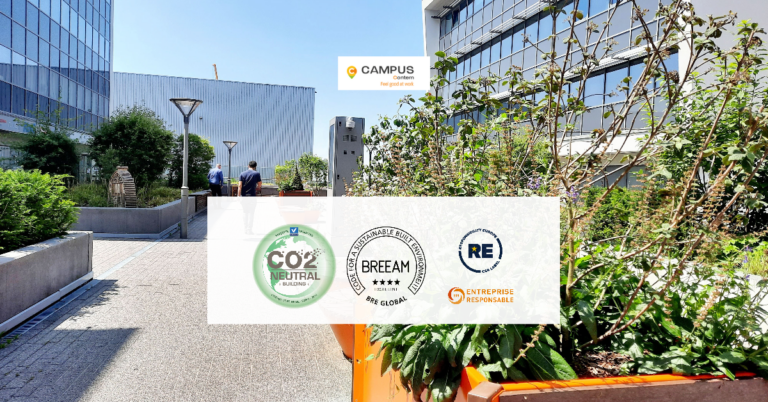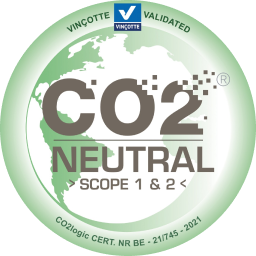Campus Contern is the first office building complex in Luxembourg to be certified CO2 neutral. The label, awarded by an independent Belgian office, is also validated by Vinçotte.
“From the very first developments of Campus Contern, it was obvious to me that the buildings we were going to build had to meet high ecological requirements. Our offices are BREEAM (Building Environmental Assessment Method) ‘Excellent’ certified, which testifies to eco-responsible site management, high energy performance from construction to the end of the building’s life, but also to the comfort of the occupants,” explains Marc Diver.
Since its creation, a series of initiatives have made this campus a pioneer in eco-responsible projects: “Being eco-responsible means taking concrete action,” he insists.
The electricity produced by the photovoltaic panels is immediately injected into the national Creos network. “Unfortunately, Luxembourg is not yet allowed to use its own energy, but the electricity we use is of course also 100% green,” adds the CEO. The site was the first to test autonomous shuttles – with Sales Lentz – to encourage its tenants to take the train by filling the last mile with a safe and regular mode of transportation. An electric car-sharing system, a carpooling system, the MéGO! collection and recycling system, and of course the BioOrg air purification system are some of these environmentally-friendly “little extras.
Analyzed, certified
It was therefore quite natural for Marc Diver to want to have his carbon footprint assessed a few months ago in order to confirm the performance of his buildings and to offset the remaining emissions. To do this, he called on a Brussels-based consulting firm. “CO2logic offers the ‘CO2 neutral’ certification to organizations that calculate, reduce and offset their impact on the climate. Since 2015, the ‘CO2 neutral’ label is also validated by the independent third-party certifier Vinçotte,” the website reads.
The calculation of the carbon footprint of the campus was based on the Damier building (3,245 m2 of offices and coworking spaces). For example, the experts noted the different materials present, and made suggestions to further reduce the carbon footprint in case of future works or constructions. For example:
– Campus Contern favored fiberglass for insulation, a solution with 70% less impact than rock fiber. The ideal choice is straw, which is 164% less “impactful” than mineral fiber, since plant-based insulation absorbs carbon during production.
– Concrete foundations account for 30% of the total carbon footprint of Campus Contern, while on average they account for 50%.
– The carbon footprint of the 4 buildings involved is estimated at 15,812 tCO2e: 90% for construction materials, 2% for demolition and 8% of “operational” carbon emissions (calculated on the basis of the annual consumption of the buildings). This last very low percentage comes from the fact that the buildings use only green electricity, including for heating (heat pumps).
The firm CO2logic proposes, in order to compensate for carbon emissions (especially those, irremediable, of the building site), to invest in carbon compensation projects. Here, the action is indirect, but allows to finance projects that change the situation: reforestation, hydroelectric power stations, etc.
Finally, the experts are also attentive to communication, prioritizing – of course – transparency, responsibility, authenticity and impact, and strongly rejecting greenwashing: “Even if you only communicate on a few key activities that resonate with your stakeholders, you have to take climate action as a priority to earn the right to communicate and inspire.” “The important thing for us is to act, but with actions that have a people & planet impact,” says Virginie Ducommun, Campus Contern’s CSR referent.
Thanks to its unwavering commitment, Campus Contern has been certified CO2 neutral in the 3 different scopes:
1️⃣ scope 1: direct greenhouse gas emissions: heating, combustion, etc…
2️⃣ scope 2: indirect emissions related to the production of the energy used
3️⃣ scope 3: other indirect emissions: on site, via company travel, purchases of goods and raw materials, etc…
It is rare that a company evaluates – and compensates! – the carbon emissions emitted in scope 3.
Once again, a first was needed: it is Campus Contern ;
Curated from the Infogreen monthly dossier “Building other models”.


